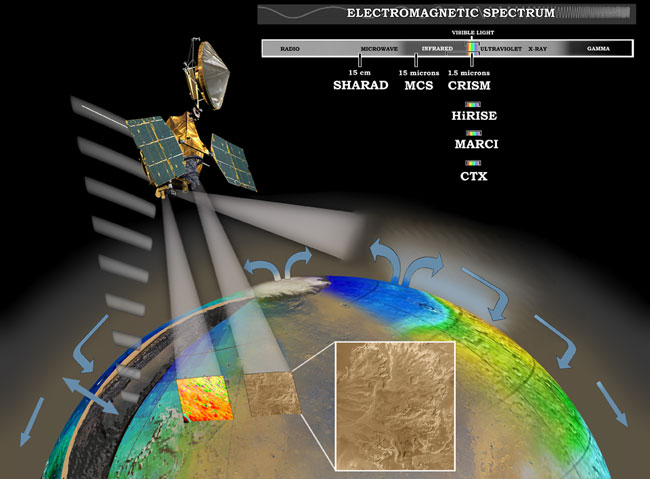New Discovery on Mars: Ephemeral Polar Water Ice Mapped

Afterdecades of studying the climate conditions of Mars, scientists have recentlymade a breakthrough observation. At the last conference of the AmericanGeophysical Union (AGU) in San Francisco, Dr. Adrian Brown reported on thelatest results of the instrument that led his team to find water on Mars.Brown, a research scientist at the SETI Institute who studies climatesimilarities between Mars and Earth, says that finding water on Mars makes thepotential for past or even future life on Mars much better.
Brown'steam found a substantial amount of ephemeral (short lived) water ice in thepolar regions of Mars. Early models of the s easonal caps of Mars suggested thepolar caps would be pure carbon dioxide (CO2), and indeed, we nowknow that Mars' seasonal polar caps are 99% CO2 ice. Later thinkingon the subject predicted that enough water existed in the Martian atmosphere toform a band, or "annulus," of water ice around the polar caps as theyreceded during springtime. This was subsequently confirmed in the northernhemisphere, but water ice in the southern hemisphere remained elusive anddifficult to find until now.
The Compact Reconnaissance Imaging Spectrometerfor Mars, or CRISM, is the instrument that made possible the recentdiscovery of Brown's team. Johns Hopkins University in Maryland operates CRISM,which is carried onboard NASA's Mars Reconnaissance Orbiter. CRISM has twentytimes the resolution of past Mars mineral mappers, allowing an unprecedentedanalysis of surface content, as well as the first compositional mineral maps ofMars. It collects a digital image made up of pixels; each pixel spans 15 to 20meters on the surface of Mars. These pictures are then compiled or examinedindividually as surface footprints. "CRISM could take a picture of twoMartian houses, just to give you an idea of how detailed these imagesare," Brown explained.
The resultsof the CRISM observations identify some striking similarities between the Earthand Mars. The recentstudy of the first CRISM data — reveals frozen H20, whichappears in small patches within and on the edge of Mars' southern polar cap asit recedes in springtime. In addition to seeking this form of ice, Brown alsostudies ice composed of CO2, with his search focused on the southpolar region of Mars. The polar regions of both Earth and Mars have dynamiceffects on the rest of the planet. The Sun's radiation on Earth and Mars hascomparable effects, and mapping of the polar regions has lead some researchersto suggest the controversial idea that Mars is showing signs of global warming,much like on Earth.
A close examinationof data from CRISM shows an image timeline of the seasonal south polar ice cap,as CO2 ice makes the transition directly from a solid to a gaseousform in a process called sublimation. The sequence of images in this movieshows the strength of the 1.4 micron absorption band of CO2 in theseasonal cap of the south pole of Mars. Red colors show deeper absorptions,typically due to larger grains or greater abundance of CO2 ice. Blueshows little or no CO2 ice, and green and yellow are in between.This allows scientists to track the receding edge of the CO2 ice capthrough the spring. Each frame of the movie is a combination of images acquiredby CRISM over a 14-Earth-day period.
The southpolar cap of Mars grows and retracts seasonally, similar to the polar caps onEarth. As Brown said, "Understanding that whole system as a function oftime is really important and what CRISMallows us the opportunity to do. And that is the work that we were reporting onat the recent AGU conference, looking at the spring recession of CO2ice. We found some pretty interesting, unexpected effects that we haven't beenable to find before with this CO2 ice and water iceinteraction."
Brown andthe CRISM team intend to examine the so-called spring recession data moreclosely to determine whether the water ice is present in the form of clouds, orwhether it is part of a surface deposit. The ephemeral nature of these depositsand their small extent have meant they have been overlooked in the past, but asCRISM and Mars Reconnaissance Orbiter carry out their continuing mission, theMars community is gaining a greater understanding of what is happening in themost dynamic parts of the red planet.
Get the Space.com Newsletter
Breaking space news, the latest updates on rocket launches, skywatching events and more!
For more information about Adrian Brown's research on Mars, visit: http://abrown.seti.org
- Video Player: Mars Reconnaissance Orbiter
- Get to Know MRO: Top 10 Facts About NASA's Mars Reconnaissance Orbiter
- All About Mars
Join our Space Forums to keep talking space on the latest missions, night sky and more! And if you have a news tip, correction or comment, let us know at: community@space.com.









